The Bagpipe Society
Fête de la Muchosá
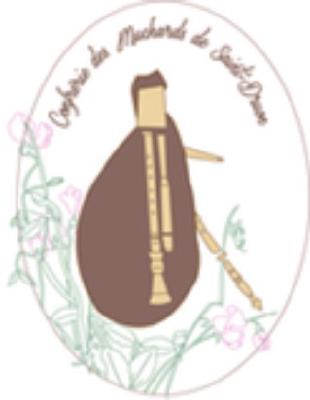
La Confrérie des Muchards de Saint-Druon, (The Saint-Drugo Brotherhood Muchosá Pipers), recently organised a bicycle tour in the region of Frasnes and Celles, just there where, until the World War I, dozens of pipers where still active. They were known in the region as “muchards” and their instruments were called “Muchosás”, which is old Picardian for ‘muse with a bag’. Each stop along the itinerary has a special significance in the history of the 19th century shepherd ‘Muchards’ and their patron saint, Saint-Drugo. The members of the Brotherhood played Muchosá, the Picardian bagpipe, at each stop a melody with a specific reference to that place.
The idea to organise a Day of the Muchosá started last year, when I prepared a bike tour for the members of La Confrérie des Muchards de Saint-Druon. It was originally to be take place on 16th April, Saint-Druon’s Day, the patron of the shepherds. But this date turned out not to be possible, because of… you know, the virus. And so 30th May was the new date that we would ride our iron horses. Sometime in March, I made the tour on my own, in order to memorise the exact trail and familiarise myself to the difficulties. I pointed out a few stops, all related to the history of the Muchards. So, one of these stops was this Farm Saint-Amandus, where our most famous old Muchard, Alphonse Gheux, spent a reasonable part of his life as a shepherd, until he bought his own sheepfold in the nearby village Ainières. But before I go further, more on the Muchosá.
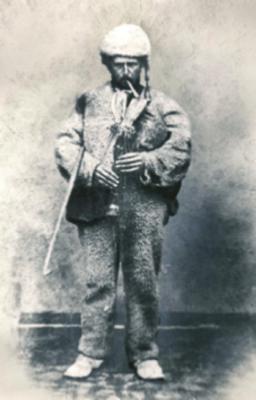
the day of the Fiertel 1885
The Muchosá is the Belgian Picardian name of a high-pitched bagpipe in Bb, one drone on the shoulder and a smaller drone next to the chanter, both to be tuned on the dominant, which is Bb. A characteristic of the chanter is the removable pavilion. The instrument is first described as “Chalemie” by Marin Mersenne in 1636 and later as “Muzelzak” in 1795 by Joost Verschuere Reynvaan. It was played the Low Netherlands, Flanders and Picardy, provided that both Flanders and Picardy are geographically and culturally located in France and Belgium. In the French region, the names Piposá and Pipasseau were used for this same instrument.
Muchard is the Picardian word for “player of the muchosá”. Between 1880 and 1914, there were muchards in nearly every village on the Walloon borders of the Scheldt. We know a few of the names of the last known muchards. Two of the three authentic muchosás in the Brussels Musical Instruments Museum (MIM) belonged to the brothers François and Thomas Piron of Arc-Ainières, the other one was last played by Jean-Louis Lehon, a shepherd from a small village, named Popuelles. There was, of course, Alphonse Gheux from Saint-Sauveur, the only one who left us a picture of himself with his instrument, and Arthur Dinne, a blind player from Dergneau. The shepherd Henniquiau, from Leuze, has been featured in a painting, and according to the text below it, he was believed to have reached the age of 118 years. Then there was a cattle breeder Fréderic Mortier, who played two polkas on the 16th birthday of young Léonie Devos around 1899, so she could sing these melodies exactly as she remembered them to Hubert Boone, a researcher at the MIM, in 1965. Probably the last event ever where the muchosá was played in public, was in 1919, when three muchards were involved and one of them was named Alphonse Van Herreweghe. The Confrèrie des Muchards was as a fellowship of pipers, in the 19th century and part of a much bigger group of shepherds, The Confrérie de Saint-Druon, which was still active up to or just after World War I. We know the location and villages of the pipers as one of their daughters, Joséphine Piron, explained it all to Hubert Boone:
When they went on pilgrimage to Bon-Secours, they started at sunrise at the church of Arc. My father, Thomas Piron (1824-1892) and his brother François, and also Arthur Dinne, a blind musician from Dergneau, guided the procession with March melodies until the village of Velaines. A few dozens more of pilgrims joined the group and another three pipers, muchards. On the road the muchards alternated each other often, but always two or three together, sometimes playing second voices. The music was beautiful. They also went once a year on pilgrimage to Oostakker, near Gent. People along the road looked always very surprised by the strange muchosá music. The only heard it once a year, when we were on the road to Oostakker. A few years after my father died, the tradition vanished slowly. Our band, the 21st century Confrérie des Muchards de Saint-Druon was inspired by the older 19th century shepherds’ brothership when they chose a name for the band.”
Now, let’s go back to the preparing of our bike tour. So, I came to Farm Saint-Amandus and I went to the iron gate to have a look on the courtyard. The lady of the house saw me and asked if she could help me. I expected to be sent away but I tried to explain to her the importance of this property for us, the “new” muchards, by telling her about Alphonse Gheux, who once spent part of his life on the farm. Instead, the lady was full of enthusiasm of my story which was completely new to her and her husband was equally thrilled. I shared my idea about our bike tour so when I left, we had an agreement that we could plan an “apéro” at the property and they would keep the beer cold in their refrigerator and in return we would play a few tunes on our muchosás.
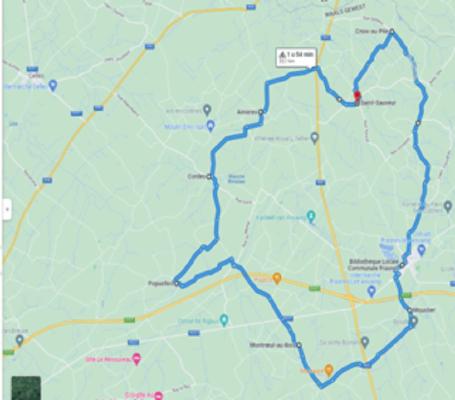
On 30th May 2021, we came together in Frasnes-Lez-Anvaing to start our ride. During my preparation, I broke the inner shaft of my bike’s main gear on a severe climb, so I had to borrow a bike from my sister. The only vehicle she could lend me was a tandem, which reminded me that 1898 song of Harry Dacre, Daisy Bell, about the bicycle built for two. However, instead of a romantic bride, such as Daisy, I found one fellow Muchard, slightly heavier than myself, to occupy the rear seat. We had to do that vicious climb again, but after that, there was that scary descent, that for a tandem with two, not so skinny occupants, was horrifying. Anyway, we arrived safe at the Farm Saint-Amandus to be greeting by Viviane, the lady of the house, who had prepared our drinks and a few bottles of her own, because, she had invited a few friends to be our audience. We spent more time on the farm than we originally planned as there was much to discover; not only the flowers and plants but the way they had restored all the buildings with to the authentic shape and materials. And then, after a while, Viviane spoke the magic words, they came out with a too long held breath, I am dreaming of a farm party with live music and a dance floor. We agreed, and yesss!!
From 2000 until to 2016, there were the Rencontres des Cornemuses in Arc-Ainières, organised by Pascale Gheux, great granddaughter of Alphonse Gheux and also one of our members Muchards. The event finally stopped because of lack of financial support by the council, but we thought that this could be some kind of small scale rebirth of the festival. We all appreciated that the organisation would be difficult due to the insecurity of the Covid situation. But finally we agreed to a bike tour, fixed the date on 2nd July, invitations were sent out, the dance floor was levelled out, so we only had to wait for people to sign up!
2nd July, Day of the Muchosá. Saint-Sauveur.
Leading up to the day, there were some intense preparations; providing tables, chairs, refrigerators, implements and ingredients for cooking as well as having to organise and transform the farm’s courtyard into an attractive festival patio. Food was brought to the Farm, including gazpacho, Dutch, French and Spanish cheeses, as well as the sea food and the rice, and all the other ingredients for the paella. Finally, all I had to do was to pick up a borrowed electric bike – my wife’s suggestion and not such a bad idea, considering an exhausting day in prospect.
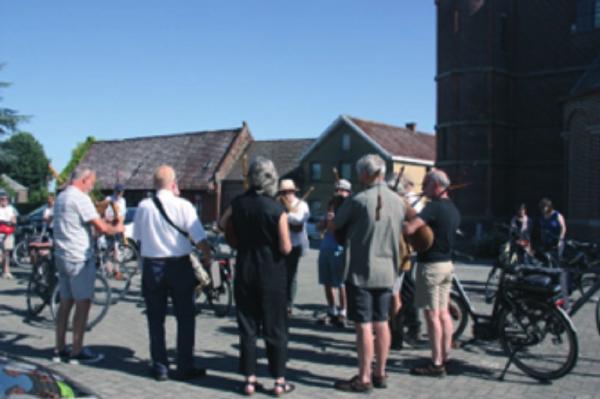
We started at 10.00am near the church in the village of Saint-Sauveur, the home of Alphonse. I didn’t really know how many people to expect for the bike tour although we were expecting over 60 people for the afternoon party. But fine weather was forecast for the whole day and in the church square there were 33 cyclists, including 8 muchards. This included Pascale Gheux, our fellow muchard, who volunteered to follow us with her car, carrying our instruments and a water supply. Before setting off on the bikes, the muchards played a West-Flemish tune, called “Waar, waar, waar?”.
We then proceeded to Ainières where, in the cemetery, one can find the gravestone of Alphonse Gheux, who died in 1936. He is the only traditional Belgian piper to be photographed with his instrument.
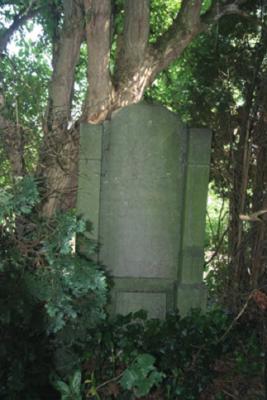
There was a fear that the graves would be exhumed as, back in 2021, there were plans to turn the cemetery into a ‘green’ space. Luckily, one year later, it was still there, and we played as a tribute to the old shepherd ‘De Bedevaartsmars de Jean-Pierre Van Hees and la Marche de Pélérinage de Arc-Ainières’. The first tune is a recent composition by Jean-Pierre Van Hees, dedicated to Hubert Boone, from the Brussels MIM, the man who did all the research about the muchosá in the 1960’s. The second tune was field recorded in the village by Hubert Boone, of the playing of Léonie Devos (1883-1976) This tune was often played by the old muchards in the town of Forrest, also on our cycling route.
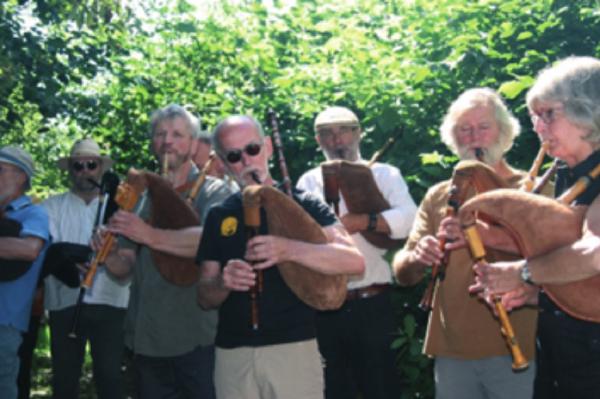
The next stop was the beautiful 12th century church of Cordes which is well worth a visit. It has wonderful acoustics and we played ‘Ach Bélinde and Laet ons gaen te besoeken’ The first tune is found in a manuscript “country dances of the Netherlands” the second in a carillon manuscript “Beyaert 1728”
Then it was on to Popuelles, the village where where the shepherd Jean-Louis Lehon (1817-1901) lived. He owned the muchosá now known as number 1980.047 in the permanent collection of MIM in Brussels. It probably dates from the 18th century, and was made by a shepherd called Nart, who lived in Moustier (Frasnes-lez-Anvaing), according to the inscription on the big drone. The instrument has also very nice carvings, a ram’s head on the chanter stock and a shepherd with sheep and dog, as well as a chapel, on the bass drone. The chapel on the drone is clearly the chapel of Moustier whilst the inscriptions next to the shepherd mention Saint-Druon à Sébourg, born in Calvain/Pinoi. I see these inscriptions and sculptures every day, since my muchosá is a perfect copy of the instrument of Popuelles.
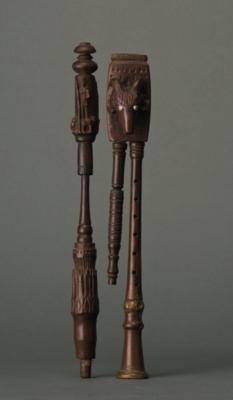
Later, Charles-Louis Lehon (1817-1901), a shepherd living in Popuelles, used the instrument. In 1972, the Belgian bagpipemaker Rémy Dubois heard about the instrument and found it in the nearby village Escanaffles, while he visited the shepherds’ grandson, Marcel. It was offered to the museum later. Muchards played here ‘La Danse en Rond de Arc-Ainières’
This is also one of the 4 tunes of Arc-Ainières, field recorded by Hubert Boone from Leonie Devos (1883-1976), who remembered this original piper tune and the other three tunes so she could sing them exactly as they sounded on the muchosá in her youth.
Montroeul-au-Bois is one of the pilgrimage destinations visited by the Confrères Muchards in the 19th century. As a tribute to them we played ‘Maria door een Doornwoud trad’, an old song to the Virgin Mary.
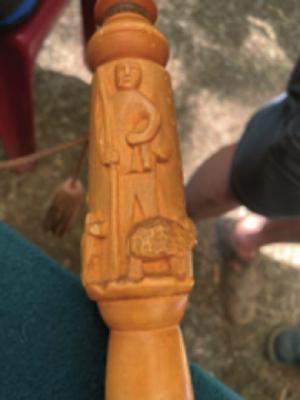
Leaving this place meant a really tough climb of 15%. Those who relied on pedal power rather than electric support had to stop to rest on the way.. When we arrived in the village of Moustier, it was time to enjoy our picnic. Moustier is known as the village with two churches, but in reality, it has a church and a big chapel. We rested on the terrace of a nice pub and ordered ourselves a fine local beer, Saison Dupont. The pub’s owner was interested and I shared our story about the connection of my bagpipe, the copy of the Popuelles’ Muchosá with the chapel of Moustier. La Chapelle Notre Dame de Moustier, is the chapel that is sculpted on the big drones of Muchosá nr 1980.047 in the MIM. We serenaded the publican with a tune, also as tribute to Monsieur Nart (Naert ?), the shepherd/ bagpipemaker who has made this fine muchosá of Moustier. The tune was Den Bastaert from a manuscript (1743) by Petrus Josephus Van Belle. The manuscript, with dozens of lovely music-scores, most of them dance tunes playable on pipes, was found around 1970 in the village of Viane, in the inside of the church organ, during the restoration works.
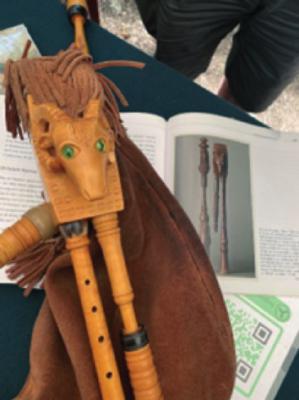
It was a tough climb to the highest point of the region to reach the tiny chapel dedicated to Saint-Druon, the only one in Belgium. There are a lot more of chapels and churches dedicated to Saint-Druon in the North of France. According to testimonies, the older Confrères Muchards came together on pilgrimage annually, April 16th, the saint’s day of Saint-Drugo, and from there they went to a secret destination. In honour of this patron of the shepherds, we played “Marche pour Saint-Druon”. We acquired this melody in 2010 from the Harmony of Sébourg, near Valenciennes in France.
After a sharp descent, we arrived at the chapel Croix ou Pile, where we, as the traditions demands, played on our muchosás ‘la Marche de Pélerinage d’Arc-Ainières’ going three times around the chapel exactly as the original Confrérie des Muchards de Saint-Druon had done in their day. This chapel is particularly significant as it is one of the locations for an old pilgrimage route where the bones of Saint-Hermes (who was believed to cure madness) were carried around a number of villages on a 35km trail. The old Confrérie des Muchards de Saint-Druon accompanied the pilgrims playing on their muchosás, and it is on one of these pilgrimages, in 1885, that the famous photograph of Alphonse Gheux is taken with him wearing the traditional outfit of sheepskin. The old pilgrimage still takes place going three times around the chapel Croix ou Pile is part of the tradition.
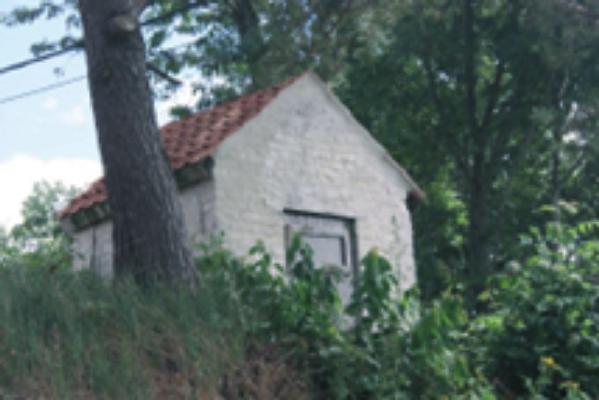
We finally arrived back in Saint-Sauveur at the farm. There was plenty of time before the formal party but the gathering of musicians had started.
Jean-Pierre Van Hees, the famous piper and pipe teacher, brought three musicians from Asturias in Spain, two pipers and a violinist, and he started the session with them. It was a lovely ambience and the artisanal local beer and the sprinkling cider flowed profusely in the hot weather. There was a TV crew of a local Channel of the Wallonie Picarde who asked me for an interview. The Confrérie des Muchards de Saint-Druon performed a series of tunes specially chosen for the muchosá.
In the meantime, my wife, Maria Eugenia, was preparing the paella. I had to skip the last song of our set and I quickly changed my instrument for an apron and a pair of spoons to start frying the seafood. An hour later, the paella was ready to serve and the rest of the buffet was ready to receive the first hungry guests in the queue. The huge paella pan, 90 cm in diameter and 4 handles, needed a pair of extra hands to be moved to the buffet table!
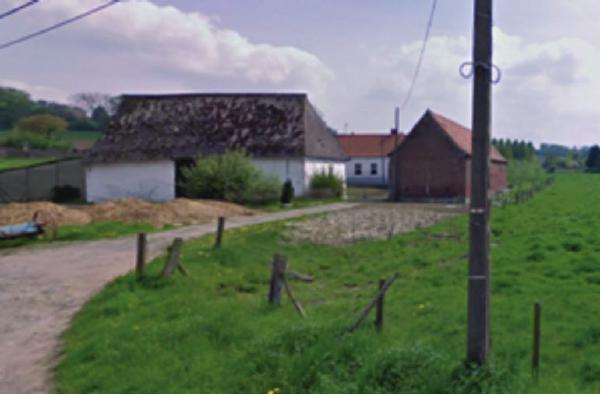
For this first edition of what, hopefully, might be an annual recurring event, we decided not to provide any form of sound amplification at all. This was also the wish of the owner, Viviane, because she was concerned that it would take all the magic away. At first I was a bit worried, but it turned out that the roof of the little shed, that was prepared as a stage for the band, had excellent acoustic properties. Étoile Musette, a trio with banjo, cabrette (French bagpipe), drums, accordion and voice, as a perfect band for this event. Raquel Gigot, the accordionist, recited the history of the Bal Musette and explained how Italians arrived with their accordions, overshadowing the original cabrette. As a tribute to these Italians, Arnaud Degimbe played on the Zampogna, the huge Italian bagpipes, accompanied by Dick Vander Harst on Piffero, a traditional Italian shepherd oboe. The stories and the songs were lovely, but the music was very danceable.
After the concert-ball homemade pies and deserts were served. The musicians continued to play for quite some time and all stayed on late, enjoying this magic evening on the Farm Saint-Amand. All thanked us for a beautiful day and evening.
Contact pol.ranson@gmail.com https://www.muchosa.be
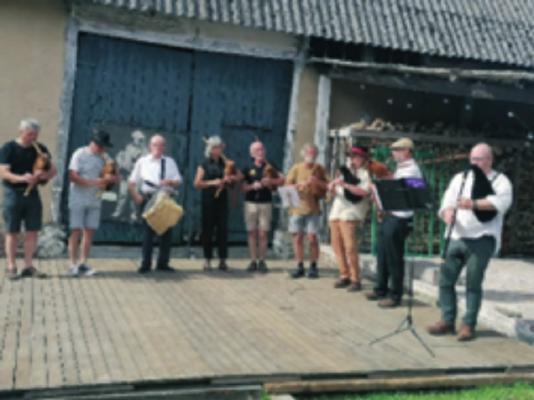
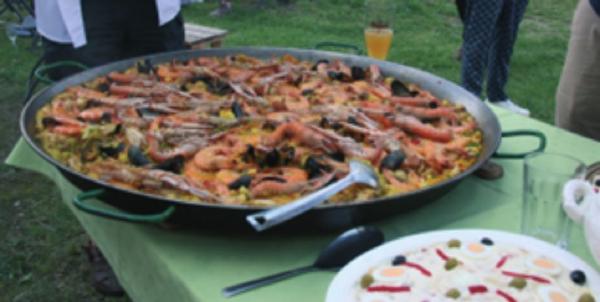
- Data Processing Notice (GDPR)
-
@BagpipeSociety on X (formally known as Twitter)
-
TheBagpipeSociety on Instagram
-
 BagpipeSociety on Facebook
BagpipeSociety on Facebook
Something wrong or missing from this page? Let us know!
